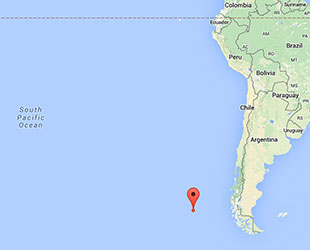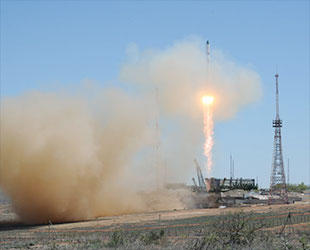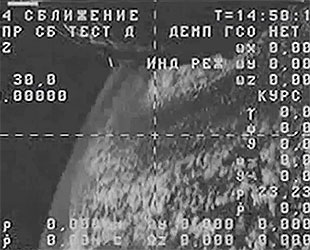May 7, 2015 – An out-of-control, uncrewed Russian cargo spacecraft fell back to Earth on Thursday (May 7), a week after failing to reach the International Space Station.
The Progress M-27M (59P) freighter, which was launched April 28 on a routine resupply run to the orbiting laboratory, re-entered the Earth's atmosphere at 9:04 p.m. CDT (0204 GMT May 8) while over the Pacific Ocean, Russia's space agency reported.
"Progress M-27M ceased to exist," Roscosmos stated on its website, adding that the spacecraft met its end on the 160th orbit around the planet. It was not immediately clear if the report was based on observed data or predictions.
U.S. Strategic Command gave a re-entry time of 9:20 p.m. CDT (0220 GMT) over the South Pacific to the west of the southern tip of South America.
Prior to its plunge, Roscosmos officials said that the craft, which doesn't have a heatshield, would mostly disintegrate during the re-entry.

Map showing location of Progress M-27M re-entry as reported by U.S. Strategic Command. (Google Maps) |
"The ship will completely burn up in the atmosphere of the Earth," the Roscosmos statement read. "Only a few small pieces of structural elements may reach the surface."
Progress M-27M was the 59th Russian cargo craft to be launched to the station since November 2000. It was only the second Progress in 37 years to not reach its intended destination (the first, M-12M in 2011, was lost in a launch failure).
Under normal circumstances, the Progress vehicles, after departing the station emptied of their cargo and repacked with trash, are purposely directed into the atmosphere to be discarded during a destructive re-entry over the ocean.
M-27M, however, had anything but a normal mission.
Launched on top of a Soyuz-2.1a rocket from the Baikonur Cosmodrome in Kazakhstan on April 28 at 3:09 a.m. EDT (0709 GMT; 1:09 p.m. local), the craft's ascent began well enough.
"The launch went smoothly [and] the spacecraft separated from the rocket. We found out however, that we lost the telemetry information from the spacecraft," said Alexander Ivanov, first deputy head of Roscosmos.

Progress M-27M launches atop a Soyuz rocket from the Baikonur Cosmodrome, Kazakhstan on April 28, 2015. (RSC Energia) |
Russian flight controllers reported that the Progress had deployed its solar panels but were unable to confirm if it had extended its navigational antennas or pressurized its propulsion system to perform the thruster burns needed to rendezvous with the space station.
Video taken on the Progress later revealed it was tumbling out of control. The spacecraft was observed spinning with a full revolution every 4 or 5 seconds.
Attempts to gain control of the vehicle failed. Roscosmos declared the Progress lost the day after its mission began. All that remained was to wait for the Progress to fall back to Earth.
Estimates varied on when that would happen. Roscosmos on Thursday pegged the entry for sometime between 5:13 and 8:51 p.m. CDT (2013 to 0151 GMT). The U.S. Joint Space Operations Center predicted 8:52 p.m. CDT (0152 GMT) in the northern Pacific Ocean.
The Aerospace Corporation targeted 9:41 p.m. CDT (0241 GMT), plus or minus two hours. The company, which has a website that tracks re-entries, projected Progress to fall over the Atlantic Ocean off the coast of Africa.
It is not known if any parts from the Progress survived the plunge the Earth.

Still frame from a video taken by the Progress M-27M spacecraft revealing it tumbling out of control above the Earth. (NASA TV) |
Progress M-27M was launched with more than three tons of food, fuel and supplies for the station's six-person crew, including 1,940 pounds (880 kilograms) of propellant, 110 lbs (50 kg.) of oxygen, 926 lbs (420 kg) of water and 3,128 lbs (1,420 kg) of spare parts and experiment hardware.
The station has sufficient supplies onboard to support its six-person crew, though Russian media reports suggested that without the Progress' delivery of waste storage bags, the cosmonauts were having to ration use of the toilet.
A NASA-contracted SpaceX Cargo Dragon spacecraft is scheduled to launch supplies in June and a Japanese H-II Transfer Vehicle is slated for August. The next Progress was also scheduled to launch in August, though that may now change.
It is not yet known what caused Progress M-27M to spin out of control. A still ongoing investigation has focused on a potential problem with the Soyuz rocket's third stage.
Progress M-27M is not the first spacecraft to fall to Earth solely under the pull of gravity.
The United States' first space station, Skylab, reentered in 1979, raining debris over Australia. More recently, NASA's Upper Atmosphere Research Satellite (UARS) fell into the Pacific Ocean in 2011, and Russia's Phobos-Grunt probe splashed down off the coast of Chile after failing to depart for Mars in 2012.
